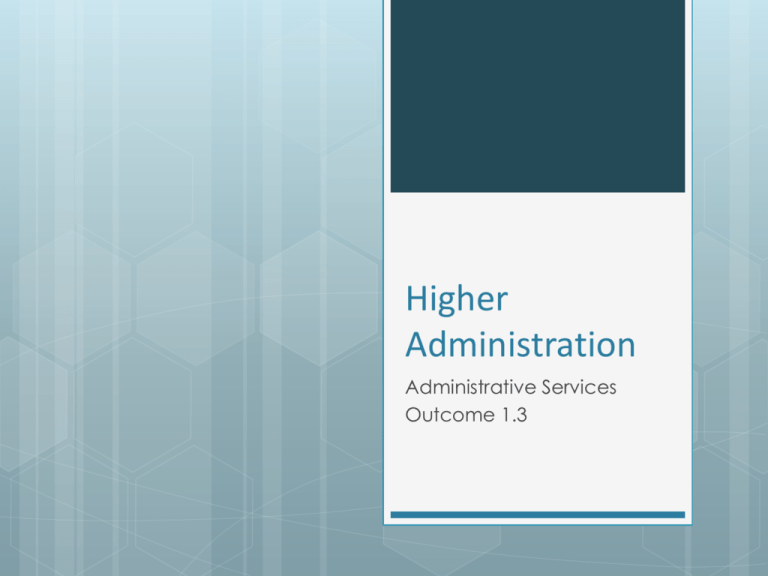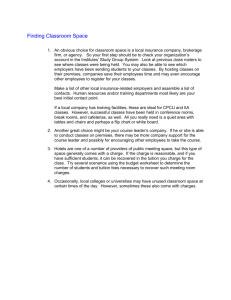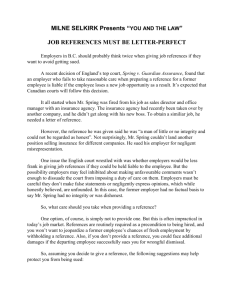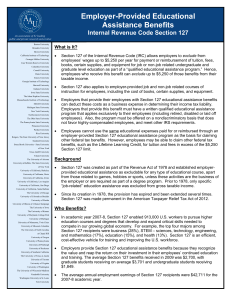Outcome 1.3 PowerPoint
advertisement

Higher Administration Administrative Services Outcome 1.3 Organisational and Legal Requirements Legislation You need to know about the following: Health and Safety at Work Act (and others) Data Protection Act Computer Misuse Act Freedom of Information Act Copyright, Designs and Patents Act General Health and Safety The work environment must meet minimum standards in terms of heat/light/first aid provision. Employers have a responsibility for carrying out regular risk assessments of activities Employees must take reasonable care of themselves and others Employees have a responsibility to take all reasonable care in the use of equipment, reporting hazards, wearing protective clothing, reporting hazards and accidents Health and Safety Responsibilities Both employers and employees have responsibilities The main piece of legislation is the Health and Safety at Work Act (1974) - it covers minimum standards that have to be met – HASAWA This is an ‘umbrella’ act containing a number of other acts, covering specific areas of H&S Employee’s Duties Take reasonable care of their own health and safety and that of others Cooperating with the employer on health and safety Correctly using work items provided by the employer, including personal protective equipment, in accordance with training or instructions Not interfering with or misusing anything provided for health, safety or welfare. Employer’s Duties Making the workplace safe and without risks to health for everyone including regular maintenance of equipment Establish safe methods of working and carry out regular risk assessments Ensuring ‘articles’ and substances are moved, stored and used safely Providing adequate welfare facilities eg toilet facilities Give the information, instruction, training and supervision necessary for employee health and safety. (including induction training) If there are 5 or more employees - a health and safety policy statement is required Internet Research Visit the Health and Safety Executive. This website has lots of very useful information and is an excellent way of keeping up to date with the changes in legislation. Follow the links to find out what procedures need to be followed to report an incident at work. What does RIDDOR stand for? Also follow the link to find out what your rights and responsibilities as a worker are. Produce a display to communicate your findings Other HASAWA Legislation Reporting of Injuries, Diseases and Dangerous Occurrences Regulations (RIDDOR) 1995 Health and Safety (Display Screen Equipment) Regulations 1992 Control of Substances Hazardous to Health (COSHH) 2002 In addition in 1993 six European Health and Safety directives were enforced in the UK – the six-pack Research these pieces of legislation and produce a short paragraph on each – covering some of the main points Informing Employees of their Duties and Responsibilities A written Health and Safety policy must be provided to all staff ( >5 employees) HASAWA only provides minimum requirements! Informing Employees of their Duties and Responsibilities Employees must be aware of and comply with all instructions Induction training Ongoing training eg new equipment installed Company Intranet Noticeboards/Posters eg fire procedures, caution signs Demonstrations eg first aid, evacuation simulation Staff Development Training Organisational Handbook Staff Meeting Health and Safety Representative DVDs, Videos, LCD Screens Quizzes on a VLE The Health and Safety Executive including local Environmental Health Departments Enter and inspect premises – sometimes unannounced. Issue improvement notices and provide advice. Question and interview people and give warnings. Shut down premises. Fine or prosecute when necessary. Star Wars prosecuted over Harrison Ford injury The production company behind Star Wars: The Force Awakens is being prosecuted over the incident in which Harrison Ford broke his leg. The actor was struck by a hydraulic metal door on the Pinewood set of the Millennium Falcon in June 2014. The Health And Safety Executive has brought four criminal charges against Foodles Production (UK) Ltd - a subsidiary of Disney. A spokesperson added: "By law, employers must take reasonable steps to protect workers - this is as true on a film set as a factory floor.“ BBC News Article Industrial Tribunals Employees can take an organisation to an Industrial Tribunal if they believe the organisation has breached the legislation designed to protect them eg Non-provision of safety equipment Failure to remedy a hazard – injury occurred Disciplinary Procedures (Employees) Depending on the seriousness of the breach of Health and Safety Legislation: A verbal warning A written warning Suspension Fine Dismissal Criminal or civil prosecution Apart from this, the employee may harm themselves or others The organisation may be found guilty of failing to support or train staff. Further Consequences (Employer) Unwanted media attention Company reputation damaged Loss of new customers/sales/profits Existing customers switch to rival Difficult to attract high quality candidates in the recruitment process Legal action (costly) - Fines/sanctions/compensation payments May be forced to close down business Further Consequences (Employee) Employment terminated Poor job reference Lack of income – financial hardship Demoted May harm customer indirectly by misusing information – stress/guilt/demotivation Health and Safety (Display Screen Equipment) Regulations 1992 If you had written this legislation what would you include? Health & Safety (Display Screen Equipment) Regulations 1992 Some of the potential risks include: Eye strain Back pain/ache Repetitive Strain Injury (RSI) Headaches Ensure that workstations meet minimum requirements Provide users with training to avoid health problems Organise the daily work of VDU users so that there are regular rest breaks or changes of activity Arrange and pay for regular eyesight tests for VDU users – the employer is required to pay for any spectacles or lenses which are required as a result of VDU use at work. (Note: eye tests are free in Scotland now) Fire Precautions (Places of Work) Regulations 1995 If you had written this legislation what would you include? Fire Precautions (Places of Work) Regulations 1995 Under this legislation employers should: Assess fire risks in the workplace Check fire detection time and warning system Check evacuation routes Provide reasonable fire fighting equipment Check employee knowledge of fire procedures Check and maintain fire safety equipment Health and Safety (First Aid) Regulations 1981 If you had written this legislation what would you include? Health and Safety (First Aid) Regulations 1981 Under this legislation employers should: Provide a suitably stocked first-aid box A first-aider should be appointed One for every 50-100 employees Employees informed about first aid arrangements 24 Data Protection Act 1998 obtain and process information fairly and lawfully register the purposes for which they hold it not disclose the information in any way that is different from those purposes only hold information that is adequate, relevant and not excessive for the purposes they require only hold accurate information and keep it up-to-date where necessary not hold the information for longer than necessary give individuals copies of the information held about themselves if they request it – amending/erasing as necessary keep information safe Data Protection Act 1998 KEY POINT OF LAW obtain data fairly and lawfully IN PRACTICE people must be told what use will be made of the information they supply about themselves data must be adequate, relevant when designing forms to and not excessive for its purpose collect data, make sure only key questions are asked data must be accurate and, ensure that there are where necessary, kept up-to-date procedures in place to check, up-date or destroy inaccurate information data must be held for no longer data should be destroyed as than is necessary soon as its purpose has been served eg credit card details Internet Research Using your research skills find some examples of how the Data Protection Act has been breached in recent years. Ask to see notes showing examples of how the Data Protection Act is applied with a college application form 27 Computer Misuse Act 1990 accessing computer material without permission e.g. looking at someone else's files accessing computer material without permission with intent to commit further criminal offences e.g. hacking into the bank's computer and increasing the amount in your account altering computer material without permission e.g. writing a virus to destroy someone else's data writing a virus or deliberately spreading one is illegal. Computer Misuse Act 1990 KEY POINT OF LAW unauthorised access of computerised material unauthorised access with the intent to commit or help further offences unauthorised changes to contents of any computer IN PRACTICE do not access material you have no right to access do not give your password to any other person do not explore areas where you are not an authorised user only supply information to authorised members of staff do not supply information held at work to friends or members of the public changes to data must be authorised data must be real only enter data you have been instructed to enter Internet Research Using your research skills find some examples of how the Computer Misuse Act has been breached in recent years. 30 Copyright, Designs and Patents Act 1988 It gives the creators of literary, dramatic, musical and artistic works the right to control the ways in which their material may be used. The rights cover: broadcast and public performance, copying, adapting, issuing, renting and lending copies to the public. In many cases, the creator will also have the right to be identified as the author and to object to distortions of his work. Copyright arises when an individual or organisation creates a work, and applies to a work if it is regarded as original, and exhibits a degree of labour, skill or judgement. If a work is produced as part of employment then normally the work belongs to the person/company who hired the individual. Only the owner, or his exclusive licensee can bring proceedings in the courts against an infringement. Copyright, Designs and Patents Act 1988 KEY POINT OF LAW IN PRACTICE books, songs, films belong to the if copyright, do not copy text author/composer/artist unless you have permission to do so display copyright summaries at each photocopier display copies of licence agreements IT – pirating of copyright ensure all software on the protected software; copying of premises is licensed pirated software into the memory do not allow employees to of a computer copy software if suspicious, owners can apply ensure employees only use to court for the right to search software bought by the premises for pirated software company display a summary of the key points of copyright legislation Internet Research Using your research skills look at some Myths and Misconceptions surrounding the Copyright, Designs and Patents Act. Myths and Misconceptions Freedom of Information Act 2002 The Freedom of Information Act came into force on 1st January 2005. It gives you the right to ask any public body for all the information they have on any subject you choose. Unless there’s a good reason, they have to give it you within a month. You can also ask for all the personal information they hold on you. Internet Research Using your research skills find some examples of what has been found as a result of the Freedom of Information Act. BBC News Article – 10 things Security and “Health and Safety” Staff entry and movement Intercom/security doors Identification passes worn – swipe entry Careful handling and issue of keys Security and “Health and Safety” Visitors Report to reception and sign-in Reception at front door Visitor passes issued and worn Not left unsupervised All visitors to leave and passes returned Security and “Personal Data” Information Technology Use of passwords Read-only files Virus-screening software locked rooms, filing cabinets and computers Confidential documents - shredded Security and “Personal Data” General Security Measures Specialist security firms The use (and monitoring) of CCTV Register of serial numbers (asset register) Ultraviolet markers Extended Response Questions Higher Administration Administrative Services Outcome 1.3







